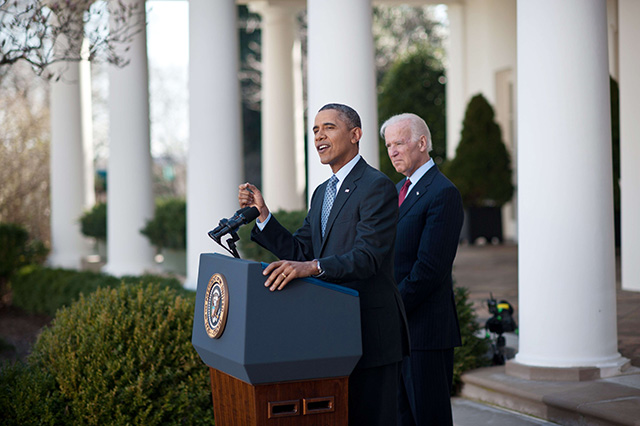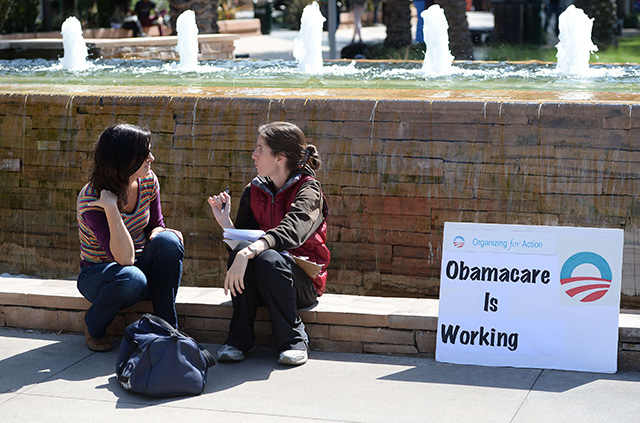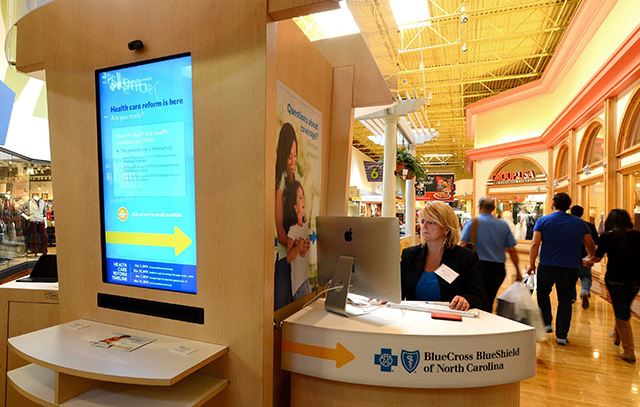In April, President Obama told the nation that “marketplace” or “exchange” enrollment, at 8 million customers as of March 31, had exceeded expectations and costs were lower than expected.
Many in the news media accepted the selectively released statistics, despite the Obama administration’s record of sometimes providing inaccurate or incomplete information on HealthCare.gov. Even today, the government continues to withhold relevant public information on costs and enrollment requested by Congress and the press under the Freedom of Information Act.
In fact, the measure of the Affordable Care Act’s success rests neither with individual anecdotes nor in the Obama administration’s self-assessments. It’s a long-term process that many analysts say will take years to unfold.
One thing that’s not in question: The insurance industry already has been largely transformed.
Many who were considered uninsurable now have affordable policies. But the Affordable Care Act has shifted the cost burden for those who already had insurance. More policies now have bigger deductibles and cost more.
“In general, healthy people are paying more and unhealthy people are paying less,” says a source who supports and helped implement Obamacare but is disappointed with the results to date, “with those above-average [income] tending to pay more and those below-average [income] tending to pay less.”
“Is the new law effective in reducing the number of uninsured? Yes, but so far not very,” he says.
Key questions include:
- How many actually have enrolled?
- How many of those were previously uninsured?
- How has Obamacare affected the overall pool of uninsured?
- What percentage of eligible people have signed up?
- What’s the cost?
The administration hasn’t released any enrollment figures in the last 2 ½ months, and a spokesman from the government’s Centers for Medicare and Medicaid Services, which helps oversee Obamacare, said the agency is not likely to issue any updates soon.

President
Obama speaks about the Affordable Care Act with Vice President Joe
Biden in the Rose Garden at the White House on April 1, 2014. (Photo:
Nicholas Kamm/Getty/Newscom)
“The Affordable Care Act is working,” said an April 17 White House fact sheet. “It is giving millions of middle class Americans the health care security they deserve, it is slowing the growth of health care costs and it has brought transparency and competition to the Health Insurance Marketplace.”
But the 8 million figure is overstated because it counted people who weren’t actually covered because they hadn’t paid their premiums, which Blue Cross, analysts and the government agree is in the 15 percent to 20 percent range.
Therefore, the actual number of Obamacare enrollees as of March 31 was likely between 6.4 million and 6.8 million, below both the administration’s figure of 8 million and its stated target of 7 million.
Nobody from the White House responded to repeated requests for comment. A spokesman for CMS said there were no plans to release figures on paid enrollment, even though health policy analyst Robert Laszewski says the administration could provide the number in days or even hours if it wanted to.
Last week, Democrats on the House Committee on Oversight and Government Reform, led by Rep. Elijah Cummings of Maryland, released a fact sheet using data from 13 insurance companies that said actual health exchange enrollments exceeded insurance company projections by 4 percent.
“This result was achieved despite significant challenges with federal and state websites,” said Cummings.
Previously Uninsured
Jackie Berman is one of Obamacare’s success stories. She had no insurance until HealthCare.gov came online. According to the government’s Facebook page touting positive HealthCare.gov stories, Berman, a special education teacher in Chicago, was left uninsurable by a car accident. Today, she is receiving federal subsidies to help her buy insurance through the health insurance marketplace created by the Affordable Care Act.
But how many new marketplace enrollees were uninsured like Berman? And how many were simply re-insuring after being bumped off their existing plans by Obamacare?
Estimates of how many marketplace enrollees were previously uninsured range from about one-third to more than half, depending on the survey and the methods used.
A recent Kaiser Family Foundation survey found that 43 percent of those who purchased insurance through the marketplace already had insurance; 57 percent are newly insured.
“The enrollment figures for marketplace coverage will grow over time, assuming that the exchange insurance plans don’t fail as a result of adverse selection,” said the source who supports and helped implement Obamacare. “But the impact on reducing the uninsured so far is very disappointing.”
The Kaiser numbers are not what the Obama administration hoped for, but they are better than other estimates. One reason for the difference is how the surveys define “previously uninsured.” Kaiser considered Americans previously uninsured even if they recently had insurance, just not when they signed up on HealthCare.gov. Other surveys excluded those from the “previously uninsured” category if they had insurance at any time during the prior year.
Laszewski said he believes about half the new enrollees were previously uninsured and many others had insurance but were shifted into the exchanges because of changes caused by Obamacare.
Those changes meant the plan offered by Virginia Beach business owner Betsy Atkinson did not meet Obamacare’s requirements, which she says left her with no choice but to drop her company’s insurance.

Virginia Beach business owner Betsy Atkinson dropped her company’s insurance. (Photo: CBS This Morning via YouTube)
Assuming the most positive estimates—that 85 percent of the 8 million enrollees have paid their premiums and 43 percent had coverage before—the newly insured would number only about 3.9 million. By this time, CBO had projected 19 million would have been removed from the ranks of the uninsured, and CMS predicted 26 million.
Fewer than 4 million newly insured “doesn’t put much of a dent in the problem,” said the source.
Many enrollees were gained due to “coverage substitution,” according to health care policy expert Edmund Haislmaier of The Heritage Foundation, which publishes The Daily Signal.
Haislmaier, who testified before the House Committee on Oversight and Government Reform earlier this month, said this means that people who had insurance then substituted what they had for new coverage with more in the way of subsidy dollars.
“If you’ve got coverage now and a government program offers a replacement with more subsidies, then you’re going to have an incentive to move to that,” Haislmaier explains. “No doubt it helps people by helping them buy something that they already had. … But it isn’t a net increase.”
Meanwhile, some who were forced out of their existing coverage but not eligible for subsidies found themselves having to re-enroll at much higher rates than before, said Laszewski.
“It was not uncommon to see [insurers] increase their [rates] by 35 percent to bring policies into compliance with Obamacare,” Laszewski said. “So, they have the same relatively healthy people with perhaps more benefits but for 35 percent more premium. That may be good news for the insurance companies but not for the individuals who are forced to pay more than a third more.”
Reduction in Uninsured
By all credible accounts, Obamacare has resulted in a reduction in the number of people who are uninsured.
The story of Lou Vincent of Akron, Ohio, is held out by the Obama administration as an example of the positive impact. He suffers from Type 2 diabetes and went uninsured for 10 years until Obamacare. Now, thanks to the Affordable Care Act, he and his wife are covered for $379 a month.
Research from RAND Corp. shows 9.3 million more people had insurance in March 2014 than did in September 2013, and a recent Gallup poll puts the uninsured rate at its lowest level since 2008. The percentage of adults who don’t have insurance has dropped from 20.5 percent to 15.8 percent in the last year.
But it’s unclear how much of the drop can be credited to Obamacare and how much to other factors, such as changes to Medicaid enrollment. RAND’s study and another from theUrban Institute Health Policy Center both found fewer than half of the newly-insured gained coverage through the Obamacare exchanges.
Co-Op Enrollment
At the state level, enrollment at state health insurance co-ops created under the Affordable Care Act is reported to be about 80 percent of what was expected for 2014.
According to statistics released this month by the Oversight and Government Reform Committee, 450,000 people signed up with the co-ops compared to original projections of about 575,000 for this year. Because the co-ops received federal loans, the committee was able to calculate how much in federal funding it has cost so far for each co-op enrollee.
The best performer from the standpoint of federal loan cost-per-enrollee is CoOportunity Health, which serves Iowa and Nebraska. It received $112.6 million in federal loans and reports signing up 76,881 enrollees as of May 1, at a cost of $1,464 in federal funding per enrollee so far.
Tennessee’s health insurance co-op, Community Health Alliance Mutual Insurance Co., reported just 354 enrollees as of April 1 at a cost of $207,081 in federal funding per enrollee, according to the committee. The co-op received a total of $73.3 million dollars in loans under the Affordable Care Act.
For the low performers, Darrell Issa, R-Calif., who leads the oversight panel, says there’s a question as to whether co-ops will be able to pay back the taxpayer loans. In its 2013 budget statement, the Office of Management and Budget projected taxpayers would lose 43 percent of the money loaned out, or $860 million of a $2 billion investment offered to two dozen co-ops.
Medicaid Enrollment
To date, it’s been the dramatic expansion of Medicaid under the Affordable Care Act that has reduced the ranks of the uninsured far more than the exchanges or HealthCare.gov. Medicaid, state-provided health insurance for the poor, is now available to those who earn up to 138 percent of the federal poverty line.

An
uninsured woman at a low-cost clinic run by the Rocky Mountain Youth
Clinics in Aurora, Colo. (Photo: John Moore/Getty Images)
Where will the money come from to fund such an expansion? The federal government is paying 100 percent of the Medicaid extra benefit cost for the first three years. Then, 10 percent of the cost will transfer gradually back to the states, which already are under tremendous budget pressure.
“State budgets are horrible. The federal budget is horrible. There’s pressure to reduce anywhere you can—but we’re just expanding,” says the inside source. “How the state and federal budgets will react to this dilemma remains to be seen.”
Overall Cost
The White House released a fact sheet in April that credited the Affordable Care Act for the fact that “health care costs are growing at the slowest level on record.”
“Since the law passed, real per capita health care spending is estimated to have grown at the lowest rate on record for any three-year period and less than one-third the long-term historical average stretching back to 1960,” it said.
But what the fact sheet did not point out, as a source told The Daily Signal, was that this “remarkable situation was also the case in 2008 and 2009, before the ACA was enacted. It’s highly misleading to imply that it results from the ACA. Most experts attribute most of the slower cost growth to the Great Recession and weak economic growth since then.”
The White House fact sheet also pointed out the Congressional Budget Office “projects the deficit will shrink more and premiums will be lower than expected: CBO previously estimated that the ACA will reduce the deficit by $1.7 trillion over two decades, and, just this week, CBO concluded that lower-than-expected Marketplace premiums and other recent developments will cut $104 billion from our deficit over the next 10 years.”

An
Obamacare supporter, right, talks with a student about the health care
law at Santa Monica City College in California last October. (Photo:
Robyn Beck/Getty Images/Newscom)
At this point, the CBO figuratively threw its hands in the air and stated that it no longer can figure the overall financial impact of the Affordable Care Act because it no longer can “determine exactly how the provisions of the ACA that are not related to the expansion of health insurance coverage have affected their projections of direct spending and revenues.”
That’s a big blow to the ability to track actual Obamacare effects on the federal budget and compare them to the original CBO estimate in 2010 that the health care law would reduce the deficit by more than $120 billion over a decade.
Future Premium Increases
What will next year’s insurance rates be?
Avalere, a health care advisory group, looked at nine states and found premium increases this year of 2.5 percent to 16 percent.
Laszewski, whose predictions have proven uncannily accurate, estimates the average cost of premiums for Americans will go up 9.9 percent next year, or just under the threshold that triggers a regulatory review under federal guidelines. He said insurers will not have adequate claims data by the time 2015 rates are due at the end of this week, so they will push rate increases to near the limit.
Today, Americans’ satisfaction with the Affordable Care Act is mixed. A recent Gallup survey found 51 percent of respondents disapprove of the health care law. Only 43 percent approve.
“A lot of dissatisfaction is being communicated from consumers to insurance company call centers and their agents about the new health insurance plans, particularly compared to the plans people are used to,” said Laszewski.

Kelli
Tremblay, an agent with BlueCross BlueShield of North Carolina, works a
station at Concord Mills. (Photo: Jeff Siner/Charlotte Observer/MCT)
On the other hand, millions got booted off of policies they said they liked for ones that they like less—that often cost more. And the resulting reduction in the number of uninsured to date is modest at best.
“This,” says Laszewski, “is going to take years to play out.”
This special feature was produced exclusively for The Daily Signal.





No comments:
Post a Comment